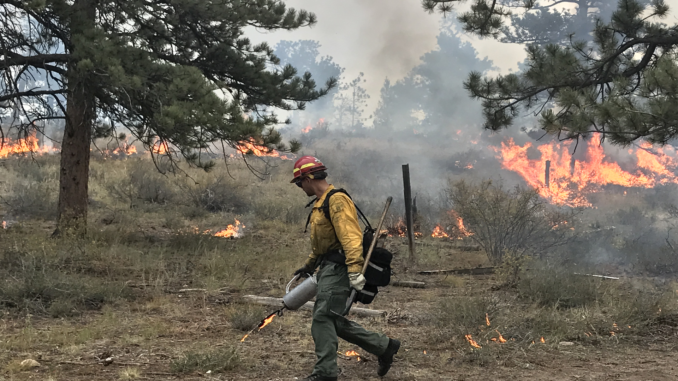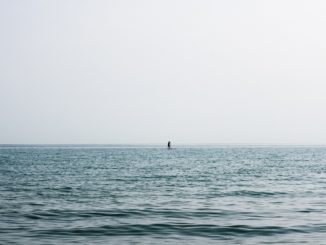
Why Prescribed Burning is an Important Management Tool for Forest Restoration
The Coalition for the Poudre River Watershed
Historically, forests in our Northern Colorado landscape were in part shaped by fire. If one were to be transported back in time to the early 1800’s, they could expect to encounter open stands of ponderosa pine and higher elevation lodgepole forests where fire played an important role in providing resilient conditions to avoid insect and disease infestations and overall forest health. In previous articles, we have discussed how fire is a central component of keeping this landscape thriving, beautiful and resilient. Years of suppressing fires has limited the important work that wildfires used to play in reducing and recycling the vegetation, both dead and alive, in our forests. This has left forests with too many trees competing for limited resources, creating overly dense and unhealthy forests that can fuel large, high-intensity wildfires.
So how do we fix it? One tool that forest and fire managers are increasingly relying on to restore our forests is prescribed burning. Prescribed burning is the controlled application of fire to the land to accomplish specific land management goals.
Although it might initially seem strange to use fire to “fix” a wildfire problem, it is an essential part of returning balance back to our forests. Prescribed fire is a cost effective and ecological way to reduce over accumulation of fire-prone fuels and promote healthier ponderosa pine and mixed-conifer forests. Wildfires that burn into areas that have experienced prescribed burning typically cause less damage, are easier to control and are safer for firefighters when a wildfire does occur.
The choice is not between no fire and lots of fire; it is a choice between an unhealthy forest and a healthy one. Prescribed fire is a chance to restore our forests so they are more resilient to natural fire.
Prescribed fires are planned and implemented by well-trained fire managers with a strong understanding of fire and fire-adapted forests, utilizing on-the-ground experience and science. These prescribed burn professionals help ensure the safety of the burn crew, nearby residents and property. Although all the risk of prescribed fire cannot be mitigated, very stringent parameters must be followed in order to reduce the risk as much as possible.
Controlling where the smoke will go is an important part of every prescribed burn. Before each burn, land managers look carefully at what they plan to burn and the proximity of houses, roads, and other smoke sensitive sites to the planned burn area. The burn prescription is then written to mitigate negative impacts of smoke, especially to individuals who may be smoke-sensitive. Smoke, however, is a natural byproduct of fire and some amounts are unavoidable.
Periodic prescribed burns prevent heavy fuel accumulation that would send a larger amount of smoke into the air should an uncontrolled wildfire occur. All prescribed burns must comply with local air quality regulations to minimize impacts to communities.
Prescribed fire is an important forest restoration tool that leverages a natural process to help foster ecosystem health and negative outcomes of wildfire. As forest managers and practitioners continue to work towards restoring our forests and watersheds, communities around Northern Colorado will start to see more prescribed fires across our landscape. If you have thoughts, concerns or questions about prescribed fire, feel free to contact us!
Upcoming prescribed fire treatments
The City of Fort Collins Natural Areas Department, in coordination with The Nature Conservancy, will be conducting a prescribed fire within Reservoir Ridge in early October or November 2018.
The Natural Areas Department conducts prescribed burns to accomplish a variety of management goals including reducing weedy vegetation, improving plant community composition for habitat goals, or to reduce the presence of hazardous fuels. This season’s efforts will focus on improving habitat for grassland birds and rare plants in addition to promoting native grasses that respond well to fire, such as buffalo grass and blue gramma.
The U.S. Forest Service – Canyon Lakes Ranger District continues to monitor conditions throughout the year to look for opportunities to conduct prescribed burning on numerous projects, including the Red Feather Prescribed Burn, Bighorn Sheep Prescribed Burn (Poudre Canyon), Pingree Hill Prescribed Burn and Elkhorn Prescribed Burn. There may also be slash pile burning in areas where fuels reduction work has previously taken place. Those interested in getting on a notification list, please send an email to [email protected].
Upcoming events
We are hosting a fun opportunity for people to learn more about our forests and the history and ecology of wildfire on Saturday, September 22nd from 10am-12pm at Gateway Natural Area. Join CPRW and our partners for a free field trip to learn more about how wildfires influence vegetation, wildlife and rivers. Email hallys@poudrewatershed for more information or to RSVP.
Did you know that the Cache la Poudre River is the only river in Colorado that is designated as Wild and Scenic?
This year is the 50th Anniversary of the Wild & Scenic Act! CPRW, Wildlands Restoration Volunteers and the USFS will be organizing 2-3 short restoration projects in the Wild and Scenic corridor in the Poudre Canyon on Sunday, September 16th. The morning restoration project will be followed by a celebration at The Mishawaka with opportunities to have fun, learn about other conservation groups, and to listen to live music. Email hallys@poudrewatershed for more information.
Interested in volunteering on a forest restoration project? Contact weston@poudrewatershed for opportunities this fall.
The Coalition for the Poudre River Watershed is a local non-profit whose mission is to improve and maintain the ecological health of the Poudre River watershed through community collaboration. For more information visit www.poudrewatershed.org or email [email protected]
Support Northern Colorado Journalism
Show your support for North Forty News by helping us produce more content. It's a kind and simple gesture that will help us continue to bring more content to you.
BONUS - Donors get a link in their receipt to sign up for our once-per-week instant text messaging alert. Get your e-copy of North Forty News the moment it is released!
Click to Donate


